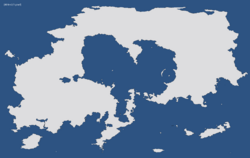Novus Romanum Imperium
New Roman Imperium Novus Romanum Imperium | |
|---|---|
|
Flag | |
| Motto: "The Senate and People of Rome " "Senātus Populusque Rōmānus" (Latin) | |
| Anthem: "Glory to the Romans" "Gloria Romanorum" (Latin) | |
 Map of the NRI | |
| Capital | Rome, NRI |
| Largest largest city | Caesarium, NRI |
| Official languages |
|
| Ethnic groups (2020) | 91.3% Roman 8.7% Other |
| Religion | Cultus Deorum (Roman Paganism) |
| Demonym(s) | Roman |
| Government | Federal Constitutional Democratic Republic |
• Caesar | Gallus Paesentius Belletor |
• Praetor of the Senate | Oppius Plotius Sellic |
• Vice-Caesar | Rusonia Octobriana |
| Legislature | Senate |
| Establishment | |
• Rise of the Roman Monarchy | 1287 |
• Establishment of the NRI | TBD |
| Area | |
• Total | 93,164,520 km2 (35,971,020 sq mi) |
| Population | |
• 2020 census | 1,046,600,000 |
• Density | 11.23/km2 (29.1/sq mi) |
| GDP (PPP) | 2020 estimate |
• Total | $50 trillion |
• Per capita | $47,773 |
| GDP (nominal) | 2020 estimate |
• Total | $50 trillion |
• Per capita | $47,773 |
| Gini (2020) | low |
| HDI (2020) | very high |
| Currency | Denarius (DEN) |
| Date format | dd/mm/yyyy (CE) |
| Driving side | left |
| Calling code | +8675309 |
| Internet TLD | .rom |
NRI, officially the New Roman Imperium (Latin: Novus Romanum Imperium), is a transcontinental sovereign, federal constitutional democratic republic composed of twelve provinces located on the continent of Terra Nostrum, each exercising a limited degree of autonomy from the Roman Government based in the nation's capital of Rome. The NRI is bordered by the Mares Neptune in the center, Salacia in the south, Antonia in the west, and Magnificum in the north and east. The NRI comprises an area of 93,164,520 square kilometers (35,971,020 sq mi) and a population of 1,046,600,000. Much of the nation's population is centered around the cities of Rome, Caesarium, Syracusium, Castra Romulus, Bonna, Chersonnesos, Constantinople, and Praeesseptentrionalis. The NRI is a monocultural country, with the majority of the population being ethnically and culturally Roman, and the people speak a modern form of Latin. The nation’s climate is tropical, and the geography varies between tropic lowlands and mountains.
The first people migrated to Terra Nostrum around X BCE/CE. These were Romans who had been banished from the Roman Empire due to their following the Cult of Neptune Ultor, a sect of Roman Paganism that worshiped Neptune. The Roman religion feared Neptune, and as followers, these Romans were seen as outsiders. After landing, a small town was established where they landed, which they named after their old capital: Rome. Population quickly boomed, and the Romans began to spread over the continent, establishing city-states, principalities, and duchies. When the monarchy rose in Rome in 1287, many of these minor kingdoms bent the knee. Those who didn’t formed a loose coalition against the aggression of the Roman Monarchy. Over the next several hundred years, the coalition nations merged and split as the monarchy remained a constant, slowly growing. As this happened the King gained more and more power, leading a peasant’s revolt in 1592. The revolt ended with the Peasant Army, led by Legate Decius Salvius Scrofa, storming the Royal Palace, slaughtering the Royal Family. Scrofa then consolidated power, and named himself Protector of the Realm, reforming the monarchy into the Roman Empire. The establishment lead to a period of expansion, consuming many smaller duchies. Protector Scrofa was assassinated by his elite bodyguard, the Praetorian Guard, after he planned to attack a close ally of the Empire. The power vacuum gave way to the Imperial Civil War in 1615, which ended in the fracturing of the empire. It split into 3 nations. These nations warred with each other over the next hundred years. In 1715, the biggest of these nations, reformed itself into a democracy. Smaller states flocked to this nation, hoping for protection. By 1840, most of the continent had united under The Republic. The two holdout nations were the two remnants of the Empire. In 1860, the two nations declared an alliance and attacked The Republic. Though the coalition had early successes, the industrial might and manpower available to The Republic negated those victories, leading to the collapse and integration of the Coalition into The Republic in 1869. The Republic changed its name to the New Roman Imperium.
